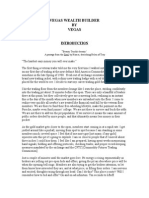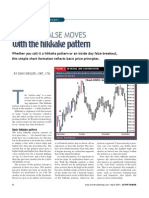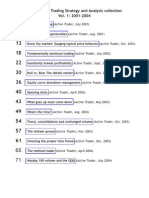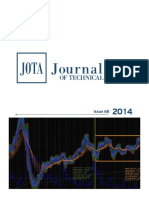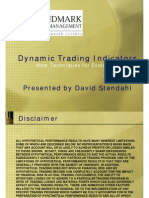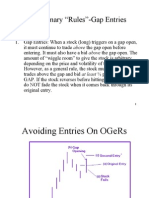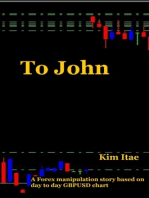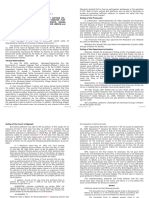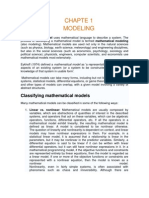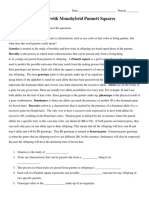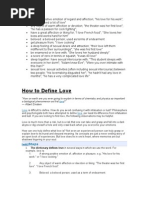Market Deception PDF
Market Deception PDF
Uploaded by
nerimarco38Copyright:
Available Formats
Market Deception PDF
Market Deception PDF
Uploaded by
nerimarco38Original Description:
Original Title
Copyright
Available Formats
Share this document
Did you find this document useful?
Is this content inappropriate?
Copyright:
Available Formats
Market Deception PDF
Market Deception PDF
Uploaded by
nerimarco38Copyright:
Available Formats
An ear l y pr edi c t or f or st oc k s?
4
0
0
2
c
e
d
/
v
o
n
.technicalanalyst.co.uk www The publication for trading and investment professionals
The January Barometer
Outlook for CAD Fine-tuning Fibonacci
Identifying when
reversals are likely
Behavioural Finance
Investor psychology
& the charts
Long-term view
remains bearish
Techni ques
November/December 2004 THE TECHNICAL ANALYST 23
Background
The pattern concept is that of a brief
pause in market action as defined by a
decrement in volatility, followed by a
false directional move. Volatility is
measured simply as the (hourly, daily, or
weekly, etc.) high to low range.
Academics might say the hikkake plays
on the short-term mean reversion
properties of markets, by identifying
situations where prices have been
stretched past their short-term equilib-
rium value. Momentum is generated in
the early stages of the reversal path,
causing prices to return to and eventu-
ally through their prior equilibrium
level. Technicians on the other hand,
should recognize the hikkake pattern as
a quantified compressed-time version
of the traditional "shake-out" pattern
(see Figure 1).
The rationale for why the hikkake
concept should have any effectiveness
may be due to the behavioral tenden-
cies of small traders. Research by
Goetzmann and Massa suggest that
individuals (i.e., the public) are predis-
posed to "chasing" performance on a
short-term basis, and are equally predis-
posed to reversing their decisions when
the market moves against them. In
other words, individuals tend to be
short-term performance trend follow-
ers. In the case of the hikkake pattern,
perhaps it is the initial breakout that
attracts smaller participants into the
market. Another source of buying and
selling comes from technicians and sys-
tem traders. Buying and selling around
predefined narrow ranges is an
extremely popular concept that goes
back at least to the early 1900s (see
Figure 2). In fact, strategies based on
this idea gained in popularity following
articles and books written by fund
manager Toby Crabel in the late 1980s.
However, if prices fail to gener-
QUANTIFYING MARKET DECEPTION
WITH THE HIKKAKE PATTERN
by Daniel L. Chesler
A savvy old timer once described Wall Street as "the only place
where they put prices up when they are having a sale." Indeed,
deception is a feature of most competitive fields including politics,
biological systems, financial markets and sports. Take for instance
the dummy move commonly used in football. The idea is to move
in one direction, thus unbalancing your opponent, before moving
away quickly in a different direction. The hikkake pattern is the mar-
ket's version of the dummy move. Hikkake is a J apanese verb
meaning to trap or to ensnare. In western terminology, the proper
name for this pattern would be inside day false breakout.
L ONG BASE WI TH SHAKE- OUT MOVE
Fal s e B r eak
Ral l y To
New Hi ghs
Figure 1. This graphic, from William Jiller's classic 1962 book on charting, illustrates the tra-
ditional style "shake-out" pattern, which has also been described by authors such as
Schabacker, Wyckoff, and Edward & Magee. Hikkake patterns differ from this traditional
"false move" schematic primarily in respect to time.
ate the expected trending behavior fol-
lowing a breakout, a potential pool of
"trapped" new commitments is created.
Increased buying or selling pressure
from the unwinding of these losing
positions is one possible reason why
prices continue moving in the opposite
direction of a failed breakout. Another
possible source of fuel propelling the
market after a false breakout is the
opening of new positions in the direc-
tion of the true trend. For example,
many popular breakout strategies advo-
cate placing stop and reverse orders
after an entry.
Description
The basic hikkake pattern is formed by
the combination of two price bars (two
hourly bars, two daily bars, two weekly
bars, etc.). The first bar must be an
"inside" bar, which is defined as any bar
that is completely encapsulated by the
previous bar's range. The second bar in
the pattern must have both a higher
high and a higher low than the previous
(inside) bar for a bearish hikkake set up,
or a lower low and a lower high than
the previous (inside) bar for a bullish
hikkake set up. Note that the hikkake
pattern ignores the positions of the
open and close, known as the "real
body" in candlestick terminology. This
is not atypical; other traditional candle-
stick patterns such as tweezers, hang-
ing-man lines and hammers also ignore
the open to close relationship.
Once a hikkake pattern has formed,
the pattern is confirmed after prices
return up through the high of the
inside bar (for a bullish set up) or down
through the low of the inside bar (for a
bearish set up). Confirmation also
serves as the entry trigger when using
the pattern for trading purposes.
Normally I look for confirmation to
occur within three bars following the
initial, two-bar hikkake pattern. Upon
entering a position, risk is defined by
using the highest high (for shorts) or
lowest low (for longs) within the pat-
tern as a stop out point. This is not nec-
essarily the low (or high) of the false
move following the inside bar, since the
lowest low (or highest high) can also
occur anytime within the three bar peri-
od allotted prior to entry. The test
results presented in this article are
based strictly on the foregoing entry
and stop placement rules.
Examples
Unlike most price patterns that fall into
either "continuation" or "reversal" cat-
egories, the standard hikkake pattern
plays both roles equally well depending
on where it occurs within a trend. In
order to help the reader understand
how one pattern can play two very dif-
ferent roles, bullish chart examples will
be presented. All charts are from the
current year. Bearish examples will not
be presented due to space, but are mir-
ror opposites of the bullish examples.
In April, June bond futures were in a
powerful downtrend. The market was
making new multi-month lows, long-
term moving averages were pointing
down, and directional movement stud-
ies were showing that the strength of
the downtrend was actually increasing
(these indicators are not displayed for
sake of clarity). On April 26 an inside
day formed, giving us the first half of a
potential hikkake pattern (leftmost
point 1 in Figure 3). The next day
(point 2), a bar with both a higher high
and a higher low formed, completing
the bearish hikkake setup.
Confirmation came quickly, on April
28, as the market traded below the low
of the inside day. A second bearish
hikkake pattern formed between April
30 and May 3, and was confirmed when
the market fell below the low of the
inside bar on May 4. Both of these
examples were found in the context of
an existing downtrend and demonstrate
how a bearish hikkake pattern func-
tions in a continuation role.
Next we will look at an example of a
bearish hikkake functioning as a rever-
sal pattern. The EUR/ USD currency
pair peaked in early 2004. After correct-
ing down into May, the EUR/ USD
Techni ques
24 THE TECHNICAL ANALYST November/December 2004
Figure 2. This graphic illustrates a technique for trading based on the narrow-range phenome-
non (volatility expansion-contraction). From A. W. Wetsel's (Wetsel Market Bureau, Inc.) A
Course in Trading, 1933, with permission from Donald Mack.
Techni ques
November/December 2004 THE TECHNICAL ANALYST 25
began a gradual, low-momentum
recovery. On July 15 an inside bar
formed (point 1, Figure 4). The next
day, July 16, the market formed a high-
er high and a higher low (point 2), ful-
filling the requirements for a bearish
hikkake. Confirmation came within two
bars, on July 20, as the market fell
below the low of the inside day.
Testing method and results
Tests were not aimed at determining
whether the hikkake has any value as a
stand alone system, but rather to find
out how often confirmed hikkake pat-
terns represented valid false breakouts.
The ensuing moves were counted and
categorized by their magnitude. This
information should tell us whether the
hikkake pattern adds value as an analyt-
ical tool and can be used to guide our
entry and exit points.
For each valid hikkake pattern that is
confirmed within three bars following
pattern formation, a trade is entered
either long or short. The amount of
capital risked on each trade is defined
as the difference between the highest
high (or lowest low) of the confirmed
pattern and the entry price (either the
low or the high of the inside bar).
The test uses a static protective stop
that remains in its original location and
does not trail up or down as the trade
matures. The test then counted how
many times the ensuing move equaled:
Figure 4.
Figure 3.
Less than 100% of initial risk
before being stopped out.
100% to 200% of initial risk
before being stopped out.
200% to 300% of initial risk
before being stopped out.
Greater than 300% of initial risk
before being stopped out.
1.
2.
3.
4.
Techni ques
26 THE TECHNICAL ANALYST November/December 2004
This information should give us some
idea as to the average magnitude of
moves following a confirmed pattern
and gives us some basis for setting
profit targets and for moving up stops
on open positions.
Markets tested include the Dow Jones
Industrial Index, Russell 2000 Index,
CBOT Bonds, COMEX Gold,
NYMEX Crude and Natural Gas,
USD/ JPY and EUR/ USD currency
pairs, and individual equities General
Electric and Microsoft. Test results do
not include trading costs or slippage.
TradeStation daily data was used for all
tests. Continuous contracts were used
in the case of futures markets, which
may or may not accurately reflect the
results of testing on individual futures
contract data.
The results of the test show that over
fairly lengthy periods, ranging from
eight years in the currency pairs to
twenty-four years in gold, the hikkake
pattern produced an average win loss
ratio (number of winning trades versus
stopped out trades) of slightly better
than 1:1.
Table 1 shows the combined results
of all trades long and short. However,
we note from data compiled during
testing, that winning versus losing
trades for some markets faired much
better than the average combined per-
formance, such as long natural gas
(3.2:1), short USD/ JPY (3:1) and short
Russell 2000 (2.6:1). Less impressive
markets included short Dow Jones
Industrials (0.9:1), short bonds (1:1),
short EUR/ USD (0.9:1) and long
USD/ JPY (1:1). (A full breakdown of
individual long and short results is
available from the author).
Research ideas
Due to its simplicity, the hikkake pat-
tern lends itself well to adaptations.
One version, which I have found effec-
tive at identifying trend reversals, takes
the standard pattern and applies the
following set of requirements to the
bar immediately preceding the "inside"
bar:
Note that since this version functions
primarily as a trend reversal pattern, it
occurs less frequently in the data than
the standard hikkake pattern.
The hikkake pattern is not limited to
traditional bar or candle charts. Point
and figure and tick-based charts, which
use a variable time axis, also exhibit
Figure 5.
RATIO
200+300
PERIOD MARKET STOPPED 100%-200% 200%-300% >300% WIN/LOSS VS 100
01/02/90 - 08/15/04 DJI 64 21 14 42 1.20 2.72
01/02/80 - 08/15/04 GOLD 131 52 32 88 1.31 2.33
07/01/94 - 08/15/04 RUSSELL 2K 22 15 7 26 2.18 2.35
01/01/90 - 08/15/04 BONDS 60 26 7 48 1.35 2.17
01/05/98 - 08/15/04 USDJPY 22 8 10 18 1.64 3.70
01/05/98 - 08/15/04 EURUSD 28 12 4 19 1.25 2.02
04/30/90 - 08/15/04 NAT GAS 37 27 10 38 2.03 1.85
08/14/84 - 08/15/04 CRUDE 68 32 18 45 1.40 2.01
01/02/90 - 08/15/04 GE 44 17 5 23 1.23 2.25
01/02/90 - 08/15/04 MSFT 41 13 13 32 1.41 3.57
LONG & SHORT COMBINED STATISTICS
Table 1.
The bar must close at the top of
its range (for top reversals) or
the low of its range (for bottom
reversals).
The bar's range must be less
than the range of the previous
bar.
1.
2.
Techni ques
November/December 2004 THE TECHNICAL ANALYST 27
hikkake patterns. Figure 5 displays an
example of both a bearish and a bullish
hikkake reversal pattern in the
EUR/ USD, from May and September
respectively.
Final thoughts
I have a prejudice that says most tech-
nical indicators and methods are simply
different ways of reflecting the same,
or very similar, information. The com-
mon threads that bind indicators, pat-
terns and methods are therefore more
interesting to me than are their appar-
ent differences. In my own work, I have
always attempted to build models that
isolate these common elements.
My first attempt at this resulted in a
less subjective way of identifying classi-
cal chart patterns by distilling patterns
into separate volatility and cyclic com-
ponents (see references). By compress-
ing the traditional, detail-rich view of
classical chart patterns down to just
two main components, I discovered a
way to increase the method's robust-
ness and improve its ability to general-
ize for unseen cases.
What patterns and concepts were dis-
tilled in order to arrive at the hikkake
pattern? Does the hikkake subsume the
minutia of other approaches? Earlier in
this article it was shown how the
hikkake concept overlaps with tradi-
tional shakeout patterns. Elliotticians
should find much in common between
hikkake reversal patterns and fifth-wave
terminations. Lastly, oscillator enthusi-
asts will find that momentum diver-
gences on a lower time frame chart will
often correspond with hikkake rever-
sals on a higher time frame.
In sum, chart patterns put traders in
a position to capture outsized moves,
while giving a defined structure for set-
ting risk parameters and exit targets.
Patterns help us develop a case for
either a bearish or bullish outlook in
conjunction with other inputs. Chart
patterns add context that statistics do
not capture. The hikkake pattern serves
all of these purposes.
Daniel L. Chesler, CMT, CTA, is a
charter member of the American
Association of Professional
Technical Analysts (AAPTA). He
provides strategic technical fore-
casts for commodity and financial
markets to proprietary traders, risk
managers and brokers. E-mail:
dan@charttricks.com
References
Toby Crabel (1990), Day Trading with Short Term
PricePatterns & Opening RangeBreakout. Traders
Press, Inc.
WilliamL. Jiler (1962), How Charts Can Help You
in the Stock Market. Trendline, Division of
Standard & Poor's Corporation.
Daniel L. Chesler (1997), "Identifying Significant
Chart Formations", Technical Analysis of Stocks &
Commodities, Volume 15.
WilliamN. Goetzmann and Massimo Massa(2003),
"Index Funds and Stock Market Growth", Journal
of Business, Vol. 76, No. 1, 1-28.
Richard D. Wyckoff (1910), Studies in Tape
Reading. Fraser Publishing.
Richard W. Schabacker (1930), Stock Market Theory
and Practice. B. C. Forbes Publishing Co.
Acknowledgement
The author wishes to thank Yohey Arakawa,
AssociateProfessor of Japanese, Tokyo University
of Foreign Studies, for his help in finding theright
Japaneseverb to describethis pattern.
UNLIKE MOST PRICE PATTERNS
THAT FALL INTO EITHER CONTINU-
ATION OR REVERSAL
CATEGORIES, THE STANDARD
HIKKAKE PATTERN PLAYS BOTH
ROLES EQUALLY WELL .
You might also like
- Vegas Wealth BuilderDocument58 pagesVegas Wealth BuilderarthurkanNo ratings yet
- Connors, Larry - Connors On Advanced Trading Strategies PDFDocument299 pagesConnors, Larry - Connors On Advanced Trading Strategies PDFnerimarco3893% (43)
- Bobble Pattern Ebook PDFDocument12 pagesBobble Pattern Ebook PDFmiralemh100% (1)
- The Day I Watched Several Traders ImplodeDocument8 pagesThe Day I Watched Several Traders Implodejanos_torok_4100% (1)
- The National Music Artist of The PhilippinesDocument38 pagesThe National Music Artist of The PhilippinesKristel Gail Basilio100% (1)
- McLarens Foundations of TradingDocument75 pagesMcLarens Foundations of TradingMarco Salviato100% (1)
- Hikkake Set UpDocument5 pagesHikkake Set UpGed WardNo ratings yet
- Make T Facility IndexDocument22 pagesMake T Facility Indexpaul.tsho7504100% (1)
- Active Trader MagaActive Trader Magazine Article - Trading Triangles - Katie Townshend Zine Article - Trading Triangles - Katie Townshend (01-2001) (Ebook Finance Trading)Document4 pagesActive Trader MagaActive Trader Magazine Article - Trading Triangles - Katie Townshend Zine Article - Trading Triangles - Katie Townshend (01-2001) (Ebook Finance Trading)Dražen StričekNo ratings yet
- Channel Breakouts: Part 1: EntriesDocument5 pagesChannel Breakouts: Part 1: EntriesdavyhuangNo ratings yet
- Fibonacci Pivot PointDocument6 pagesFibonacci Pivot PointAzrin Latiff50% (2)
- Timothy Ord - Picking Tops and Bottoms With The Tick IndexDocument4 pagesTimothy Ord - Picking Tops and Bottoms With The Tick IndexAlberto Pedroni100% (1)
- Strategic Swiss Trading System by Chuck LebeauDocument16 pagesStrategic Swiss Trading System by Chuck Lebeaubeetho1990No ratings yet
- Traders Magazine Apr 2000Document54 pagesTraders Magazine Apr 2000ashlogicNo ratings yet
- Price Pattern StudiesDocument6 pagesPrice Pattern StudiesjoeNo ratings yet
- Factor Update, April 19, 2015Document20 pagesFactor Update, April 19, 2015Peter L. BrandtNo ratings yet
- Aiq June2000Document8 pagesAiq June2000addinfo100% (1)
- Thom Hartle - Active Trader Magazine - Trading Strategies Analysis Collection Vol1Document74 pagesThom Hartle - Active Trader Magazine - Trading Strategies Analysis Collection Vol1Miroslav Zaporozhanov100% (1)
- Spotting Price Swings & Seasonal Patterns - Techniques For Precisely Timing Major Market MovesDocument14 pagesSpotting Price Swings & Seasonal Patterns - Techniques For Precisely Timing Major Market Movesshruti100% (1)
- Jeff Cooper Harry Boxer: Wizards Hit and Run The TechtraderDocument182 pagesJeff Cooper Harry Boxer: Wizards Hit and Run The TechtraderSonu KumarNo ratings yet
- Tom de Mark Trend Line ForumDocument3 pagesTom de Mark Trend Line ForumRishiRajMangleshNo ratings yet
- Jota68 2014Document80 pagesJota68 2014c_mc2100% (2)
- Combo Wave ManualDocument6 pagesCombo Wave ManualHankStoranNo ratings yet
- Market Technician No 56Document16 pagesMarket Technician No 56ppfahd100% (1)
- Volume Spikes & Index Reversals - The Technical Analyst, May 2004Document4 pagesVolume Spikes & Index Reversals - The Technical Analyst, May 2004Steffen L. Norgren100% (1)
- Specialists Use of The Media by Richard NeyDocument4 pagesSpecialists Use of The Media by Richard NeyaddqdaddqdNo ratings yet
- Trading The Connors Windows StrategyDocument11 pagesTrading The Connors Windows StrategyJoe DNo ratings yet
- Chuck LeBeau - Indicators Are Not SystemsDocument3 pagesChuck LeBeau - Indicators Are Not SystemsGreg McKennaNo ratings yet
- A Guide To Joe Dinapoli'S D-Levels™ Studies Using GFT'S Dealbook FX® 2Document20 pagesA Guide To Joe Dinapoli'S D-Levels™ Studies Using GFT'S Dealbook FX® 2Nei Lima100% (1)
- Gilmo Report Feb 2 2011Document9 pagesGilmo Report Feb 2 2011Alessandro Ortiz FormoloNo ratings yet
- TD SequentialDocument8 pagesTD SequentialOxford Capital Strategies LtdNo ratings yet
- Tim Bourquin InterviewDocument8 pagesTim Bourquin Interviewartus14No ratings yet
- Stendhal, David - Winning With Value Charts - The Key To Consistent Trading ProfitsDocument59 pagesStendhal, David - Winning With Value Charts - The Key To Consistent Trading Profitscbratton27100% (2)
- Stock Market Gaps TradingDocument21 pagesStock Market Gaps TradingneagucosminNo ratings yet
- Frozen in Analysis ParalysisDocument8 pagesFrozen in Analysis ParalysisAhmad Azwar AmaladiNo ratings yet
- Active Trader Oct 2002 - Cashing in On Short-Term Currency TrendsDocument4 pagesActive Trader Oct 2002 - Cashing in On Short-Term Currency TrendsTony MontannaNo ratings yet
- 5 Ways Post BTFD 2018Document17 pages5 Ways Post BTFD 2018emirav2No ratings yet
- Opening Range Breakout - Weekly Bars: Sensitivity TestDocument8 pagesOpening Range Breakout - Weekly Bars: Sensitivity TestOxford Capital Strategies LtdNo ratings yet
- Shane's StoryDocument15 pagesShane's StorypericciaNo ratings yet
- A Tale of Two TradersDocument4 pagesA Tale of Two Tradersmayankjain24inNo ratings yet
- The Nature of Trends - 2 EditionDocument4 pagesThe Nature of Trends - 2 Editionlaxmicc0% (4)
- Market Technician No 44Document16 pagesMarket Technician No 44ppfahdNo ratings yet
- Using Acceleration Bands, CCI & Williams' %R: Price Headley's Simple Trading System For Stock, ETF & Option TradersDocument12 pagesUsing Acceleration Bands, CCI & Williams' %R: Price Headley's Simple Trading System For Stock, ETF & Option TradersSamuel Miller100% (2)
- Bobble Pattern Ebook PDFDocument12 pagesBobble Pattern Ebook PDFContra_hour100% (1)
- Dave Landry Discretionary RulesDocument8 pagesDave Landry Discretionary RulesJack Jensen0% (1)
- Tom Dante The Progression of A Trader Surviving To Thriving A ThreadDocument8 pagesTom Dante The Progression of A Trader Surviving To Thriving A Threadseba DancerNo ratings yet
- Commitment of Traders Report Part 1Document10 pagesCommitment of Traders Report Part 1andres19712No ratings yet
- Bruce Babcock Interviews Steve BrieseDocument55 pagesBruce Babcock Interviews Steve Briesefredtag4393100% (1)
- Commodity Traders ClassroomDocument0 pagesCommodity Traders ClassroomNick ClarkNo ratings yet
- Jesse Livermore 25 Regole Di TradingDocument19 pagesJesse Livermore 25 Regole Di TradingFabio ColomboNo ratings yet
- Traders World 2010Document11 pagesTraders World 2010Charles WhiteNo ratings yet
- Market Technician No42Document16 pagesMarket Technician No42ppfahdNo ratings yet
- My Job: Trading For A LivingDocument44 pagesMy Job: Trading For A Livingeduardosa2100% (1)
- 3-D Trading: by Ryan LitchfieldDocument26 pages3-D Trading: by Ryan Litchfieldbastian_wolfNo ratings yet
- Advances in HFTDocument39 pagesAdvances in HFTnerimarco38No ratings yet
- Connors, Larry - Trading The Connors Windows StrategyDocument11 pagesConnors, Larry - Trading The Connors Windows Strategynerimarco38No ratings yet
- Tape ReadingDocument3 pagesTape Readingnerimarco3850% (2)
- Maze Solving Robot Using Freeduino and LSRB Algorithm: J.Arun Pandian, R.Karthick, B.KarthikeyanDocument9 pagesMaze Solving Robot Using Freeduino and LSRB Algorithm: J.Arun Pandian, R.Karthick, B.KarthikeyanDeac GeorgeNo ratings yet
- E.2 Barangay Dasmariñas v. Creative Play Corner SchoolDocument4 pagesE.2 Barangay Dasmariñas v. Creative Play Corner Schoolavy kamille buyuccanNo ratings yet
- Chapte 1 Modeling: Classifying Mathematical ModelsDocument7 pagesChapte 1 Modeling: Classifying Mathematical Modelstatodc7No ratings yet
- UEL-SG-7001 - Week 3 - Discussion Forum - Task 1 - Bowman's Strategy ClockDocument2 pagesUEL-SG-7001 - Week 3 - Discussion Forum - Task 1 - Bowman's Strategy ClockNea MillsNo ratings yet
- Evolium A9112 Micro Node B Commissioning Manual 174293081e02Document70 pagesEvolium A9112 Micro Node B Commissioning Manual 174293081e02faxdi123456No ratings yet
- Knight Two SwordsDocument17 pagesKnight Two SwordsRomeo Glenn BongultoNo ratings yet
- Rural TourismDocument87 pagesRural TourismPrashant Dixit100% (1)
- Additol-Tpo TDSDocument1 pageAdditol-Tpo TDSlongNo ratings yet
- Knowledge On HIVDocument7 pagesKnowledge On HIVarjuna.ellepolaNo ratings yet
- MCX Crude Oil Trading Strategy-Bhagwati AdvisoryDocument3 pagesMCX Crude Oil Trading Strategy-Bhagwati Advisorysaravanan muddukrishnaNo ratings yet
- 1 (Reserved For OBC)Document2 pages1 (Reserved For OBC)Chandrasekar ChandruNo ratings yet
- Veterinary ToxicologyDocument822 pagesVeterinary ToxicologyPau Ibarra RieraNo ratings yet
- Egyptian Searle Effect GeneratorDocument15 pagesEgyptian Searle Effect GeneratorJohn Jackson100% (1)
- Practice With Monohybrid Punnett SquaresDocument6 pagesPractice With Monohybrid Punnett SquaresAriane Rosan Bocalan Ausmolo-DionisioNo ratings yet
- Lesson Plan - Story SackDocument2 pagesLesson Plan - Story Sackapi-302276550No ratings yet
- PHD Thesis: The Predominance of Women in Public RelationsDocument347 pagesPHD Thesis: The Predominance of Women in Public RelationsGreg SmithNo ratings yet
- San Mateo Daily Journal 05-11-19 EditionDocument32 pagesSan Mateo Daily Journal 05-11-19 EditionSan Mateo Daily JournalNo ratings yet
- 07 Chapter 1Document40 pages07 Chapter 1k.touilebNo ratings yet
- ESB Level 2 Award in ESOL Skills For Life Reading QCFDocument9 pagesESB Level 2 Award in ESOL Skills For Life Reading QCFRashedul Islam RanaNo ratings yet
- Analysis of AlicanteDocument23 pagesAnalysis of AlicanteMarco Dela PolaNo ratings yet
- 21cap062 Chat Application Journal UpdateDocument5 pages21cap062 Chat Application Journal UpdateVinoth KumarNo ratings yet
- Foundation & Blood Module A1 2Document10 pagesFoundation & Blood Module A1 2Junaid Shah100% (1)
- Practice Test 13aDocument8 pagesPractice Test 13aNhin NhanNo ratings yet
- Abhi 01Document67 pagesAbhi 01api-19832205No ratings yet
- ESD/PO/044922Document1 pageESD/PO/044922Isaac TingNo ratings yet
- Fillip Level 1 Part A (A5)Document48 pagesFillip Level 1 Part A (A5)Cathy WongNo ratings yet
- New State Spaces. Urban Governance and The Rescaling of StatehoodDocument185 pagesNew State Spaces. Urban Governance and The Rescaling of StatehoodAlex Paulsen EspinozaNo ratings yet
- Learners-Packet-in-Grade-4-Science - Quarter 2Document5 pagesLearners-Packet-in-Grade-4-Science - Quarter 2Cid PonienteNo ratings yet
- Mercado vs. Court of AppealsDocument5 pagesMercado vs. Court of AppealsMj BrionesNo ratings yet
